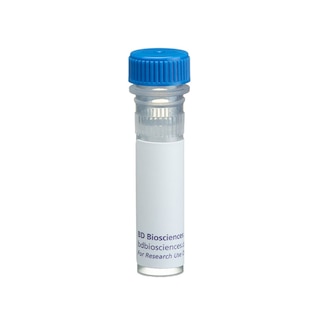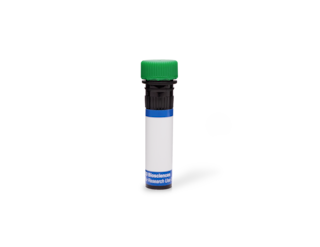-
Reagents
- Flow Cytometry Reagents
-
Western Blotting and Molecular Reagents
- Immunoassay Reagents
-
Single-Cell Multiomics Reagents
- BD® OMICS-Guard Sample Preservation Buffer
- BD® AbSeq Assay
- BD® Single-Cell Multiplexing Kit
- BD Rhapsody™ ATAC-Seq Assays
- BD Rhapsody™ Whole Transcriptome Analysis (WTA) Amplification Kit
- BD Rhapsody™ TCR/BCR Next Multiomic Assays
- BD Rhapsody™ Targeted mRNA Kits
- BD Rhapsody™ Accessory Kits
- BD® OMICS-One Protein Panels
-
Functional Assays
-
Microscopy and Imaging Reagents
-
Cell Preparation and Separation Reagents
Old Browser
This page has been recently translated and is available in French now.
Looks like you're visiting us from {countryName}.
Would you like to stay on the current location site or be switched to your location?
BD Transduction Laboratories™ Purified Mouse Anti-RONα
Clone 29/RONα (RUO)






Western blot analysis of RONα on a MDCK cell lysate (Canine kidney; ATCC CCL-34). Lane 1: 1:250, lane 2: 1:500, lane 3: 1:1000 dilution of the mouse anti-RONα antibody.

Immunofluorescence staining of HS 766T cells (Human pancreatic carcinoma; ATCC HTB-134).




Regulatory Status Legend
Any use of products other than the permitted use without the express written authorization of Becton, Dickinson and Company is strictly prohibited.
Preparation And Storage
Recommended Assay Procedures
Western blot: Please refer to http://www.bdbiosciences.com/pharmingen/protocols/Western_Blotting.shtml
Product Notices
- Since applications vary, each investigator should titrate the reagent to obtain optimal results.
- Please refer to www.bdbiosciences.com/us/s/resources for technical protocols.
- Caution: Sodium azide yields highly toxic hydrazoic acid under acidic conditions. Dilute azide compounds in running water before discarding to avoid accumulation of potentially explosive deposits in plumbing.
- Source of all serum proteins is from USDA inspected abattoirs located in the United States.
Companion Products


RON (Recepteur d'Origine Nantaise) is a tyrosine kinase receptor for MSP (Macrophage Stimulating Protein) that belongs to the hepatocyte growth factor receptor family. RON is synthesized as a single chain glycosylated polypeptide of 1400 amino acids that is cleaved upon maturation into a 150 kDa β-subunit with the kinase activity and a 40 kDa α-chain. Both chains are linked by disulfide bonds and the proper arrangement of the α and β heterodimer is necessary for biological activity of RON. MSP induces the tyrosine kinase activity of RON, triggering a cascade of intracellular signaling that leads to DNA synthesis. However, RON activation in mouse erythroleukemia cells results in apoptosis. The replacement of autophosphorylation sites Y1330 and Y1337 abolishes both the mitogenic and apoptotic effects of MSP. Therefore, autophosphorylation at Y1330 and Y1337 is required for RON's biological activity. PLCγ, Shc, Grb2, p61, and p65 associate with RON. Although widely expressed, RON is particularly abundant in epithelial tissues, lung, brain, adrenal glands, gastrointestinal tract, kidney, and testis.
Development References (4)
-
Gaudino G, Follenzi A, Naldini L. RON is a heterodimeric tyrosine kinase receptor activated by the HGF homologue MSP. EMBO J. 1994; 13(15):3524-3532. (Biology). View Reference
-
Peace BE, Hughes MJ, Degen SJ, Waltz SE. Point mutations and overexpression of Ron induce transformation, tumor formation, and metastasis. Oncogene. 2001; 20(43):6142-6151. (Biology: Immunoprecipitation, Western blot). View Reference
-
Ronsin C, Muscatelli F, Mattei MG, Breathnach R. A novel putative receptor protein tyrosine kinase of the met family. Oncogene. 1993; 8(5):1195-11202. (Biology). View Reference
-
Wang MH, Ronsin C, Gesnel MC, Coupey L. Identification of the ron gene product as the receptor for the human macrophage stimulating protein. Science. 1994; 266(5182):117-119. (Biology). View Reference
Please refer to Support Documents for Quality Certificates
Global - Refer to manufacturer's instructions for use and related User Manuals and Technical data sheets before using this products as described
Comparisons, where applicable, are made against older BD Technology, manual methods or are general performance claims. Comparisons are not made against non-BD technologies, unless otherwise noted.
For Research Use Only. Not for use in diagnostic or therapeutic procedures.